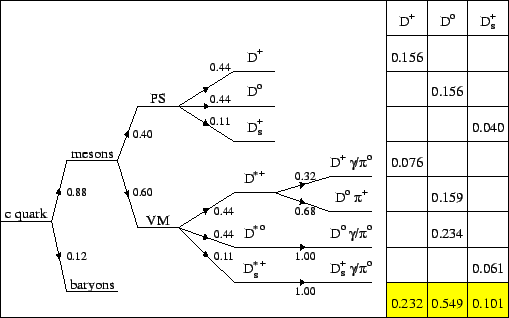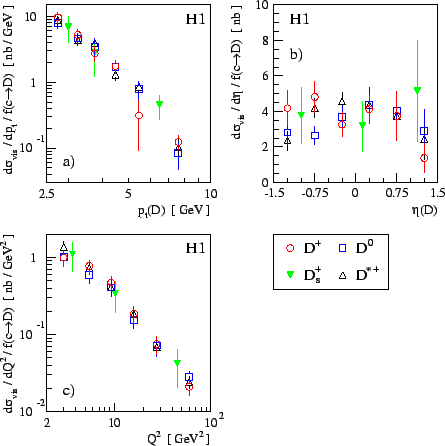The probability of a ![]() quark to hadronize as a particular charm hadron,
quark to hadronize as a particular charm hadron,
![]() ,
, ![]() ,
, ![]() ,
, ![]() or
or ![]() is described by
the charm fragmentation fractions
is described by
the charm fragmentation fractions
![]() or
or
![]() .
Like the fragmentation functions, the fractions are assumed to be universal
and previous measurements of charm cross sections have used the values
in [144] which are dominated by results from
.
Like the fragmentation functions, the fractions are assumed to be universal
and previous measurements of charm cross sections have used the values
in [144] which are dominated by results from ![]() experiments [129,155,154,157,115,116,158,159].
experiments [129,155,154,157,115,116,158,159].
The fragmentation fractions for charm at HERA are determined by separate
measurements of the production cross sections for four ![]() mesons and
the
mesons and
the ![]() baryon, in both photoproduction (ZEUS [20])
and in DIS (H14 [6]
and ZEUS [26]).
The following channels and their corresponding charge conjugates
are used:
baryon, in both photoproduction (ZEUS [20])
and in DIS (H14 [6]
and ZEUS [26]).
The following channels and their corresponding charge conjugates
are used:
![]() ,
,
![]() ,
,
![]() ,
,
![]() ,
,
![]() .
.
In fig.29 the various charmed ![]() mesons
are shown, grouped in scalar and vector mesons.
The experimentally determined fragmentation factors
mesons
are shown, grouped in scalar and vector mesons.
The experimentally determined fragmentation factors
![]() include all possible decay chains that result in that particular charmed hadron, in
addition to the direct production. The measured pseudoscalar
include all possible decay chains that result in that particular charmed hadron, in
addition to the direct production. The measured pseudoscalar ![]() ,
, ![]() and
and ![]() mesons contain a large fraction of mesons
produced in
mesons contain a large fraction of mesons
produced in ![]() decays and the
decays and the ![]() contains small fractions from decays of
the strange-charm baryons
contains small fractions from decays of
the strange-charm baryons ![]() ,
, ![]() and
and
![]() .
.
 |
 |
The differential production cross sections for all four ![]() mesons
measured by the H1 collaboration [6] in the same kinematic region
are shown in fig.30. The measured visible
cross sections are scaled by the fragmentation fractions as determined from the integrated
cross sections. The similarity of the distributions
implies that the fragmentation fractions are independent of kinematics
and can be measured from the integrated
mesons
measured by the H1 collaboration [6] in the same kinematic region
are shown in fig.30. The measured visible
cross sections are scaled by the fragmentation fractions as determined from the integrated
cross sections. The similarity of the distributions
implies that the fragmentation fractions are independent of kinematics
and can be measured from the integrated ![]() meson cross sections.
meson cross sections.
Constraints can be explicitly imposed on the measurements, which
improve the experimental
accuracy. The constraint
![]() introduces contributions to charm fragmentation processes
which are not determined in the analyses. World average
values [144] are taken instead.
introduces contributions to charm fragmentation processes
which are not determined in the analyses. World average
values [144] are taken instead.
Figure 31a shows the results for fragmentation fractions
as determined at HERA and at ![]() colliders.
The values in different kinematic regimes and at the different colliders
are in good agreement, so the assumption
that charm fragmentation fractions are universal is confirmed.
colliders.
The values in different kinematic regimes and at the different colliders
are in good agreement, so the assumption
that charm fragmentation fractions are universal is confirmed.
 |
Ratios of the total production rates are used to perform further tests of
the universality of charm fragmentation.
The fraction ![]() of
of ![]() mesons produced in a vector state is consistent
among the various experiments (fig.31b).
The expected isospin invariance of the fragmentation process, as quantified
by the observable
mesons produced in a vector state is consistent
among the various experiments (fig.31b).
The expected isospin invariance of the fragmentation process, as quantified
by the observable ![]() which gives the probabilities for a charm quark
to hadronize together with a
which gives the probabilities for a charm quark
to hadronize together with a ![]() or a
or a ![]() quark, is seen to be fulfilled
(fig.31c).
The strangeness suppression factor
quark, is seen to be fulfilled
(fig.31c).
The strangeness suppression factor ![]() (fig.31d) is found to be of order 30%.
These results support the universality assumptions for charm fragmentation.
(fig.31d) is found to be of order 30%.
These results support the universality assumptions for charm fragmentation.